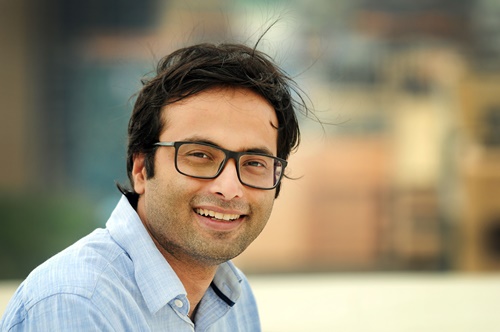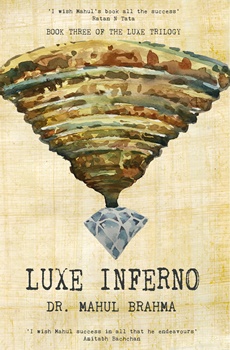Luxury commentator and columnist, Dr Mahul Brahma, the author of The Luxe trilogy — Decoding Luxe, Dark Luxe and Luxe Inferno. He heads CSR, Corporate Communications and Branding for Tata Group company, Mjunction Services Ltd. He is an award-winning communicator, CSR expert and film-maker. He is an alumnus of St Xavier’s College, MICA, IIM-Calcutta, SSSUTMS and University of Cambridge Judge Business School. He loves to paint and play golf.
In this interview with Swetha Amit, Brahma talks about his perception of luxe, millennial millionaires and his learnings after penning down Luxe Inferno.
Luxe Inferno is the third of the luxe trilogy. While your previous book explored the dark side of luxury, this one is a philosophical outlook to luxury. How did the idea of the philosophy of luxury come to you?
Decoding Luxe, the first book of the Luxe trilogy traces the evolution of luxe or dazzle. While as you rightly said the second one, Dark Luxe, is all about the darkness that hides behind this dazzle. Now, once you have the Ying and Yang covered, I thought the next logical step was a philosophical approach to find the true meaning of luxury. So, in a way, the third book was a natural extension of the thought process.
While the three books are very different and independent reads, the over-arching idea of the trilogy is to make luxury inclusive so that more and more people can enjoy and appreciate luxe. My fight has always been to free luxury from the myopic vision of price tags and unaffordability. This myopic notion is created by luxury brands for their profits because unaffordability as well as so-called luxury literature, which is basically product catalogue, aim to alienate people and create aspiration that makes the market. The trilogy aims to break that nexus and bring luxury to everyone.
Luxe inferno is an intersection between fact and fiction in other words faction. Was the book intended to belong to this novel genre called faction when you began writing it?
I have always been against compartmentalisation, even for genres. Creativity has to be fluid and so I had planned to experiment with the genre with Luxe Inferno. I had a huge assumption behind it – the maturity of my readers. I was confident that my readers will be able to accept this experiment. This trilogy thus has a very interesting mix with the first one being non-fiction, the second one fiction and the final one as ‘faction’. Dr Bibek Debroy, Chairman of PM Economic Advisory Council, had framed this term ‘faction’ while describing the book in his foreword.
The luxury industry is set to run on created perceptions. So, what is your perception of luxe?
Luxury is all about perceptions. It is all about notional value, the dazzle. Luxe Inferno is a reflection of how my perception of luxe has evolved over the years. Luxe historically has a very exclusive perception that exudes power, for example, only the royalty or rather billionaires can afford it. The next in line will be the royalty-adjacent and the millionaires, and so on. Thus, the perception cascades from there, purely based on economic status. The super-set being the “haves”, excluding the so-called “have-nots”. Over the decades, however, my perception of luxe has evolved and widened with more inclusive perception wherein everyone can enjoy and appreciate the dazzle.
The characters of Dante and Virgil are an interesting lot and quite relatable. what led you to it?
While the characters in the book are a figment of my imagination, they are certainly not limited by it. There are certain elements and potions mixed from my personal journey in finding the true meaning of luxury. Dante’s affair with luxe has been somewhat similar to that of my own. So initially I was also quite distant from luxury till I encountered my Virgil, who introduced me to this dazzle. So, my life and my quest for luxe have been the inspiration behind the characters Dante and Virgil.
It’s easy to get enticed into the world of luxe and feel powerful. Such was the case with Dante, who is otherwise supposed to be an objective person as a journalist. How does one balance this aspect of not falling prey to luxury and remaining objective?
Luxe lures its admirers like a seductress, you can’t help falling prey to luxury. The balancing act is impossible at this stage. So, for any luxury admirer, you have to give in completely and fall for charms of luxury. At that point in time, there is no room for objectivity. The lure keeps pulling you inside the luxe inferno very slowly at first and very quickly you are consumed by it. Your objectivity will start setting in only when you hit a bump. If only then you can let objectivity fight the lure, you can strike the right balance and that will give you the escape velocity to move out of the luxe inferno. It is only through these rites of passage that you understand the true meaning of luxury.
You have talked about the Catch 22 situation in Chapter 8 where the aspects of faceless brands and brands with a face are discussed. Do you think the value of a brand remains the same even after the face of the brand is gone?
In some cases, the value of the brand indeed falls but in many other cases, the value was seen shooting up manifold. In the world of luxury fashion, when the face of the brand is gone, the value has witnessed an erosion almost in all cases except a few like Chanel and Versace. The face becomes so synonymous with the brand that consumers find it very hard to go back to it when the face is no longer is associated with it. Channel and Versace have been able to build a model wherein the faces no longer represent the collections of the fashion houses. These faces remain like mentors who form the ethos of the brand and so consumers do not associate the purchase of the latest collection with say Coco, Chanel or Gianni Versace.
On the other hand, if you follow the art scene, then you will know the value of painting increases manifold after the artist is dead. There have been many instances wherein the Sotheby’s of the world have managed to collect hundreds of millions as their price rises manifold after the artist’s death. In the world of art, the brand is worth more when the face is gone.
Luxury is usually associated with power, ego, 'flaunt quotient' and supremacy. Amongst these factors, what is it that drives people to it the most?
Ego has always been the most powerful driver of luxury. Ego takes over when you start identifying with the luxury brands that you use or aspire to use. Let me share a bit from Decoding Luxe: "Ego is very tricky. It can make you, it can break you. Sometimes you may also like to say like John Lennon: “Part of me suspects that I'm a loser, and the other part of me thinks I'm God Almighty.” Just like with people, brands also have to be careful in dealing with ego."
Ego creates brands, makes them reach heights that they could have never reached with humility.
My dear Watson, said Sherlock Holmes, I cannot agree with those who rank modesty among the virtues. However, some other times it pulls them down and crushes them. Your brand has to be worth its ego. A luxury car brand once run an ad where the car did not have a fuel tank. The arrogant tagline said: “A car that runs on reputation”.
You have addressed the concept of millennial millionaires. Considering their impatience and high demands, how do you attract luxury brands to this particular segment?
All luxury brands need to take a deep dive into the lives of these millennial millionaires to understand their choices and preferences. The objective of this customer immersion is to understand a very fundamental question – what dazzles them? Given their lack of patience and high demand, no amount of 'old wine in a new bottle' strategy will work for them. What has worked, will work no more. Luxury brands have to bring in a “cool” quotient to woo them.
Traditional marketing and conventional ads in Forbes or Fortune will not work. Digital media takes precedence with stories in video formats as the attention span of this generation is reduced to five seconds. Finally, millennial millionaires swear by technology, and thus, the latest in technology carries the most “cool” quotient for them. So, all luxury brands have to keep an eye on the latest technology trends and products that lure these millennials and shape their strategy accordingly.
There have been many instances, which showcase the downside of luxury. Even in the case of Dante where falling prey to luxury cost him. Despite this known phenomenon, what is it that evades the sensibilities of people and lures them towards it?
The way luxury brands have been showcasing luxury over centuries using every available dream merchant is to be blamed for this. Over centuries these luxury brands have been wielding stories of aspiration wherein they have showcased luxury as something unaffordable, making the market in the process. It is only due to this conditioning that we are made to feel part of an imagined community. So, if I use a luxury product that was earlier used by a King or Queen, I feel a part of that legacy.
These dreams have forced people to evade sensitivities, luring them towards luxury. These dreams have forced people to believe that luxury is much more than just expensive goods, they are valued for what they represent – an identity. So, by owning these brands you feel part of that coveted “aspirational” identity of the imagined community. When you have such a deluded view of something it is only natural that you the only way to go will be down, down the circles of hell, the luxe inferno.
What have been your learnings after penning down this book?
When I had started the book, my assets were my life’s experience, my trysts with luxury and my decade-long research. Writing the book has been a great learning process as it has enriched my thought process and has taken me to nooks and corners that I had never explored earlier. The book has made me shape my notion of luxe and reaffirmed my faith in the inclusiveness of luxury. Luxe Inferno has been an emotional roller coaster ride as the dynamics between Dante and Virgil is nuanced thus demanded a high-level emotional engagement. It has been a very fulfilling exercise for an author.
Finally, what next in the pipeline?
I keep writing, so once a book is over I start working on the next. This keeps me going. So, while I am busy releasing the book or marketing it, I am already working on the next. I always pen my thoughts as and when they come so there is always substantial matter that can be put together in a book. So, the next book should be ready in a few months as I have been working on it from June last year. For the time being, let the title remain a secret.
































